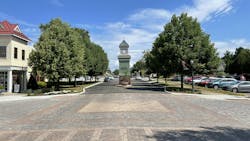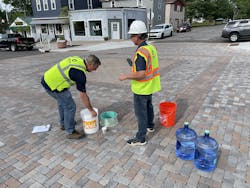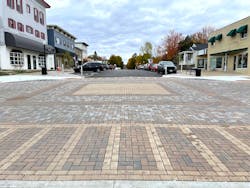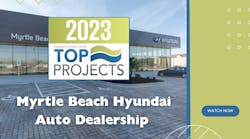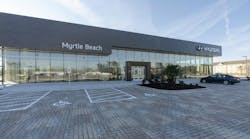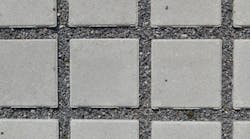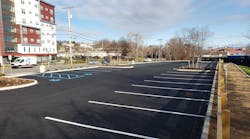The Village of Lakewood, New York, is located at the southern end of Chautauqua Lake and offers the best of both worlds. There is the tranquil charm of the lakeside village, with a public beach, park, playground, boat launch and the hustle and bustle of downtown boutiques, Amish crafts, artisan dining, antiques and wine shops.
Street life for business owners and tourists is at the heart of Lakewood Village, making it a destination in the Chautauqua-Lake Erie Region. With a need for pedestrian accessibility, safety and keeping Chautauqua Lake clean, the village initiated the Chautauqua Avenue - Green Street project, a 13,500 square-foot green infrastructure retrofit of three main intersections and pedestrian areas.
According to Randall Perry, executive director of the Chautauqua Lake and Watershed Management Alliance, funding was provided by the New York State Environmental Facilities Corporation Green Innovation Grant Program (Grant 1597) and locally from the village, County of Chautauqua, and the Alliance via grants from The Lenna Foundation, the Chautauqua Region Community Foundation, and the Holmberg Foundation.
Using permeable pavers
Completed in November 2021, the project features green infrastructure practices that reduce stormwater runoff and pollutants from entering Chautauqua Lake. Key to the water management aspects, the use of Belgard Aqualine permeable pavers provided environmental benefits while complementing the aesthetic charm of the Lakewood Village center. The project was a 2022 Hardscape North America Award Winner.
The unique use of permeable pavement for the Green Street project for the roadways is believed to be the first of its kind in New York State, along a route with regular, heavy vehicular traffic. The project demonstrates the successful use of concrete pavers in high-load applications with special design features that improve the system’s performance. There were also considerations about the nearby lake that required stormwater management and environmentally sound practices and materials. For example, stormwater tree trenches, flexible porous pavement and planted landscape areas were also installed. The streetscape also features interpretive educational panels about the green practices in the greater watershed area. For the permeable paver portion of the project, the Belgard Commercial national support team provided design and construction input to the project landscape architect.
Contracted for construction with Kingsview Enterprises and RMS Services of WNY, Inc., the project specs involved replacing asphalt pavement with permeable pavers in three main intersections along with curb areas. Barton & Loguidice (B&L), a multidisciplinary engineering firm, called for a unique design using Belgard Aqualine 4.5 x9 inch permeable pavers in four colors: Amaretto, Bella, Sable and Silex. The interlocking pavers included double-running band patterns to delineate crosswalks and 90-degree herringbone in the main areas. The smooth-surface paver field consists of joints filled with ASTM No. 89 over a 1-inch ASTM No. 8 bedding layer on a 6-inch choker course confined by geocell for additional stiffening. A 16-inch sub-base of larger aggregates functioned as a reservoir and an elevated underdrain allows water to infiltrate the ground while excess water can flow into the existing stormwater system.
“This paver system provides a beautiful streetscape while also caring for the lake water, creating an environmentally and aesthetically friendly final product for the village,” said Nicole Cleary, managing landscape architect with B&L.
Readying the retrofit
Planning for the Lakewood Village retrofit goes back to 2017, starting with a storm water management engineering study of the nearby lake and watershed. The study was completed in 2018, with the streetscape paving project included in that report.
“The Chautauqua Avenue streetscape was part of a consolidated funding application for both local and the NY State Green Innovation Grant Program,” Cleary said. “Lakewood Village was awarded the grant, and we submitted a proposal for the streetscape in Nov. 2019.”
Cleary noted that maintaining access for local business owners in the village was important to the community and success of the project.
“We tried to minimize disruption and kept sidewalks open even when roads were and the intersection was closed for periods of time,” she said. “Signs let people know that businesses were open during the summer and because of tourist season, we had to build in pedestrian access.”
Cleary explained the project’s system and process.
“Permeable pavers take water down to stone courses that it filters through and eventually goes into the groundwater,” she said. “That runoff is now captured, treated, slowed and cooled prior to entering Chautauqua Lake. We have underdrains in the permeable pavement intersections that are connected to the existing storm sewer system to collect excess water from very large rain events.
She noted that in this region they can get as much as 8-inches of rain in a 24-hour period and added that the tree wells are surrounded with flexible porous pavement that also captures rainwater and provides filtering benefits.
The results
Surface infiltration tests show that the permeable pavement system is working efficiently. The Belgard team has been involved with the project from the design phase through post-construction and has shared surface Infiltration monitoring results with the entire project team to show the effectiveness of the water management. The roadway intersections receive heavy vehicular traffic and the village’s public works department performs annual maintenance, which includes cleaning and joint aggregate replacement as needed.
Post-installation average surface infiltration rate for the site was determined to be 643 in/hr., tested in accordance with ASTM C1781. The team performed infiltration testing in 2022 and 2023 and found the system to be performing as designed. Testing at each intersection remains above 100 inches/hour.
Having the residents understand the benefits of permeable pavers is important. The pavers add to the aesthetic charm of the village, and also improve the water quality and help manage stormwater events. Cleary said communication and education within the community are essential to a project that impacts main intersections and businesses.
“Everyone seems pleased with how nice it looks,” Cleary said. “Pavers are unique for roadway intersections, but the aesthetic and water management are working very well for the village and maintenance guides were provided.”
